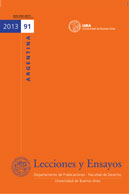El Estoppel: dificultades para definir una regla en derecho internacional y el rol deslucido de la Corte Internacional de Justicia
Keywords:
estoppel, equitable, promissory, preclusion, acquiescence, silence, faith, reliance, representationAbstract
Born as an institute of common law, estoppel was introduced in International Law through the awards of British and American umpires in the 19th and 20th centuries. Later on picked up –implicitly or explicitly– by the PCIJ and the ICJ (Serbian Loans, Legal Status of Eastern Greenland, Fisheries, and Northern Sea Continental Shelf, amongst others), it has become a peremptory objection frequently asserted. However, the International Court does not seem to have been able to specify its constituents, thus leading to an inconsistent interpretation of both silence and the so-called detrimental reliance as well. The resultant uncertainty brings doubts as to the very existence of estoppel as a rule of International Law.
Downloads
References
BOWER, G.S. & TURNER, S.K., The Law Relating to Estoppel by Representation, 4ed, Lord Hailsham of St. Marylebone, 2004.
BROTÓNS, A., Derecho Internacional, Valencia, Tirant LoBlanch, 2007.
BROWN, C., “A comparative and critical assessment of estoppel in international law”, en University of Miami Law Review (50), 369-412, 1996.
CHAN, P., “Acquiescence/Estoppel in International Boundaries: Temple of Preah Vihear Revisited”, en Chinese Journal of International Law 2004, 3, 421-439.
— “Acquiescence/Estoppel in International Boundaries: Temple of Preah Vihear revisited”, Chinese Journal of International Law 2004, 3 (2): 421-439.
CHENG, B., General Principles of Law as Applied by International Courts and Tribunals, London, Cambridge University Press, 2006.
JOHNSON, D., “Acquisitive Prescription in International Law”, en B.Y.I.L (27), 332, 1950.
MARYLEBONE, LORD HAILSHAM OF ST., Halsbury's Laws of England, 4ed., UK, L.H. Marylebone, Ed, 1992.
OVCHAR, A., “Estoppel in the Jurisprudence of the ICJ.A principle of promoting stability threatens to undermine it”, en Bond Law Review 21 (1), Article 5, 2009.
Downloads
Published
How to Cite
Issue
Section
License

This work is licensed under a Creative Commons Attribution-NonCommercial 4.0 International License.











